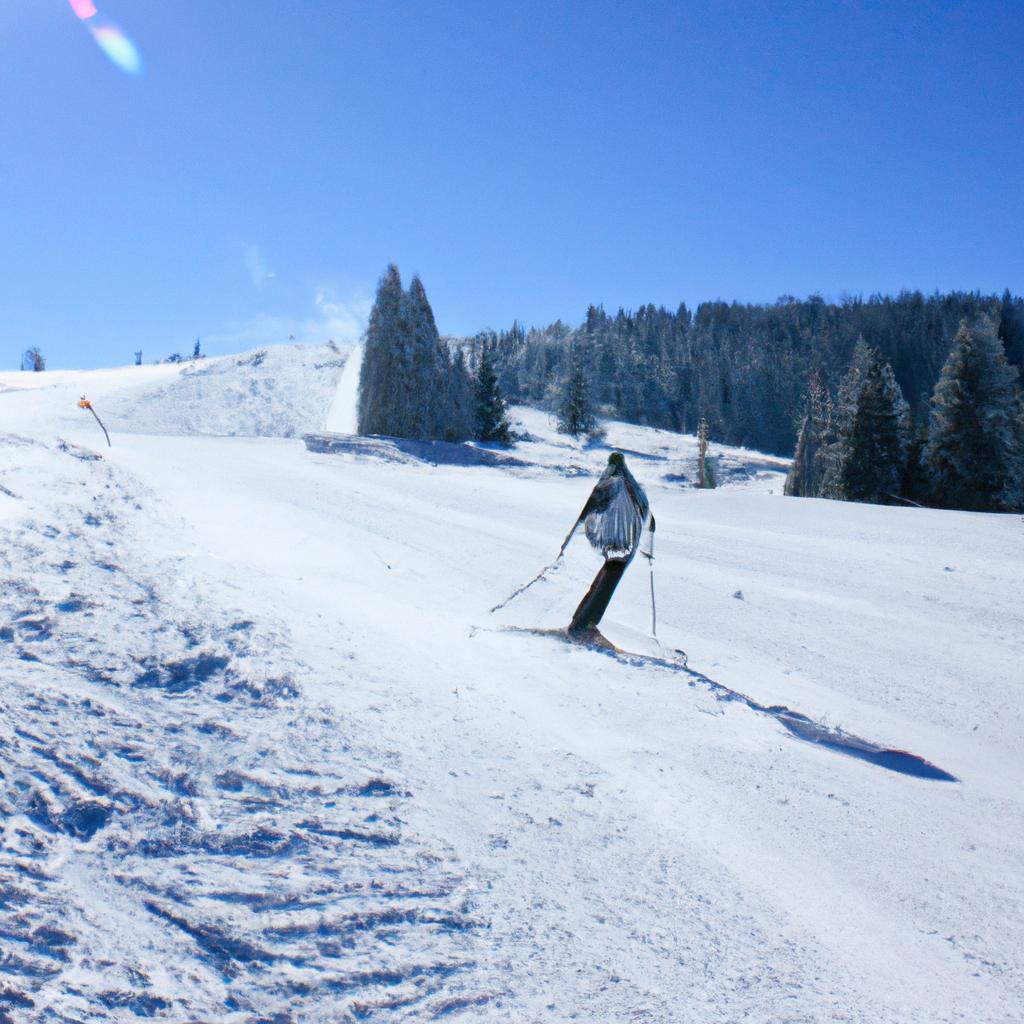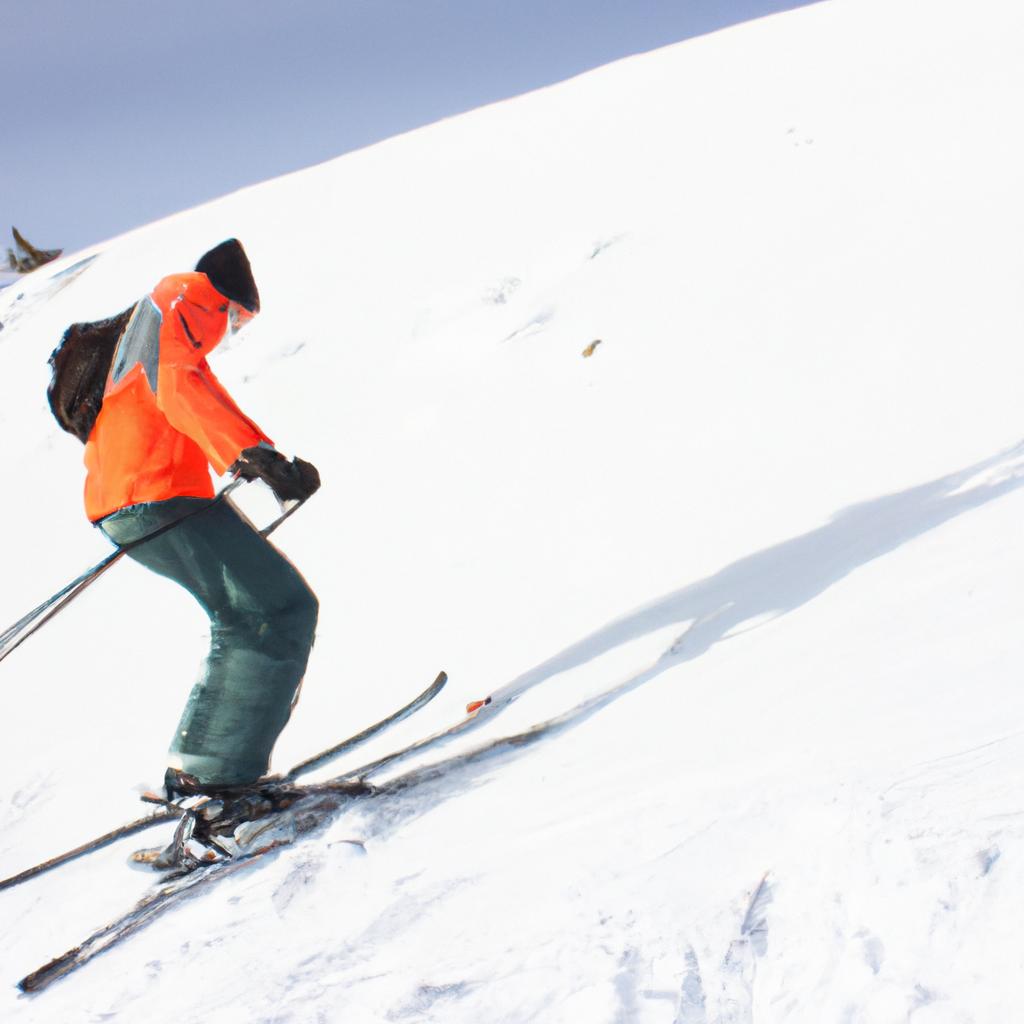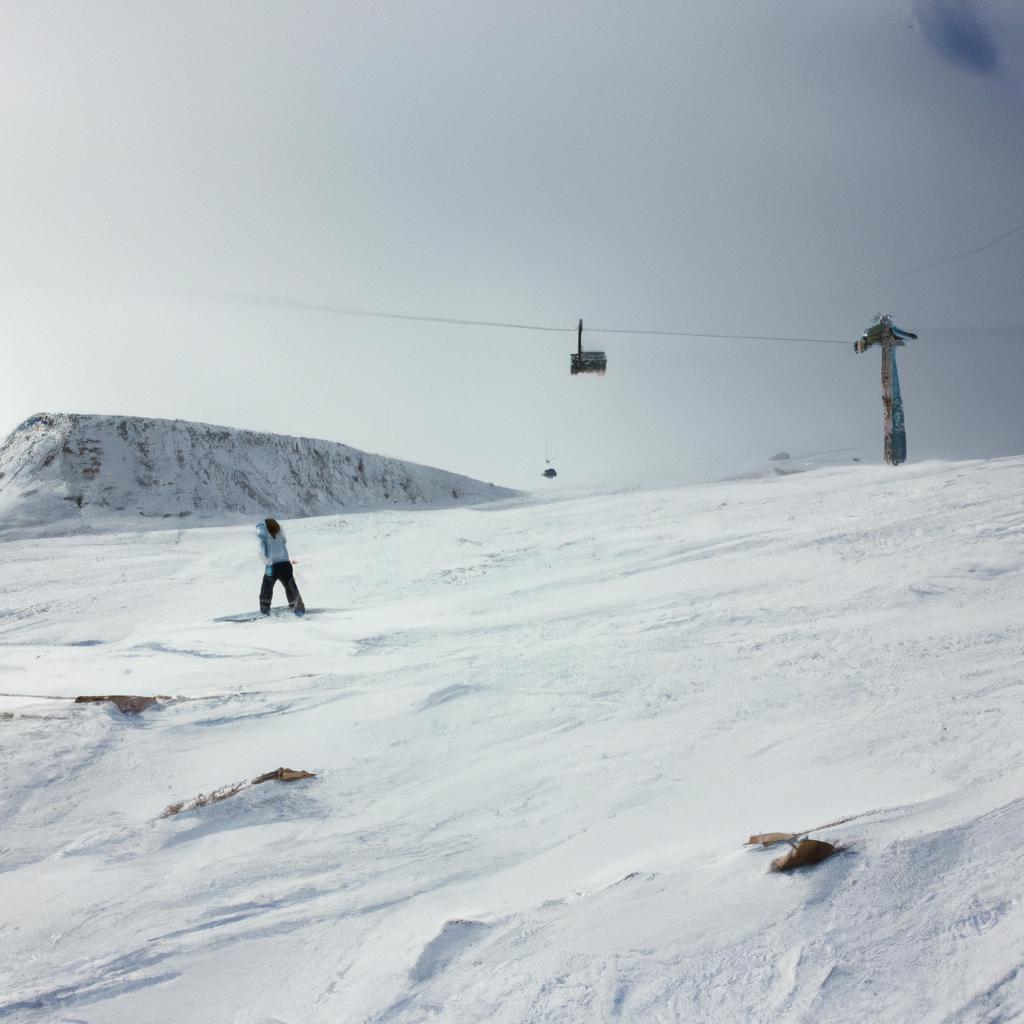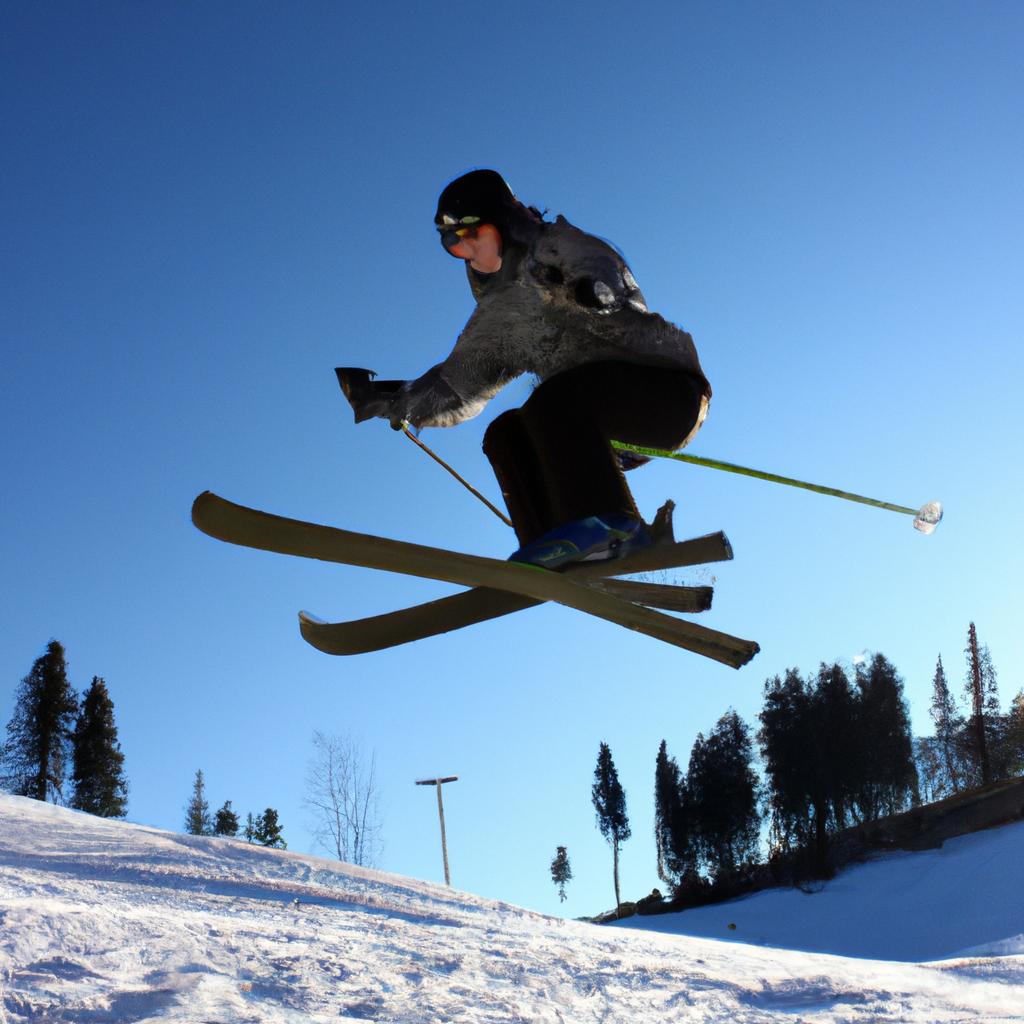Skiing is a popular winter sport enjoyed by individuals of all ages and skill levels. However, it does not come without risks. Every year, numerous accidents occur on the slopes, resulting in injuries that range from minor sprains to more serious fractures and head trauma. To ensure safe skiing practices are followed, it is crucial for skiers to be aware of and adhere to certain safety measures. By understanding proper ski technique, being knowledgeable about equipment maintenance, and practicing situational awareness while on the slopes, skiers can minimize the likelihood of accidents occurring.
Consider the case of Sarah, an experienced skier who had been enjoying her vacation at a renowned ski resort. On one particular afternoon, she decided to take on a challenging slope that pushed her skills to the limit. Despite her expertise, Sarah lost control halfway down the mountain due to a sudden patch of ice. As a result, she tumbled uncontrollably until hitting a tree, sustaining severe injuries that required immediate medical attention. This unfortunate incident serves as a reminder that even experienced skiers are susceptible to accidents if precautions are not taken seriously.
In this article, we will delve into essential tips and strategies for safe skiing based on expert advice and research findings. Ski safety encompasses various aspects such as equipment maintenance, ski technique, and situational awareness. By paying attention to these areas, skiers can greatly reduce the risk of accidents on the slopes.
Firstly, equipment maintenance is crucial for safe skiing. Skiers should regularly inspect their skis or snowboards for any signs of damage or wear. This includes checking bindings, edges, and base condition. If any issues are found, it is important to have them repaired or replaced by a professional before hitting the slopes. Additionally, ensuring that bindings are properly adjusted according to the skier’s weight and ability level is essential to prevent injuries.
Secondly, mastering proper ski technique is vital for staying safe on the slopes. Skiers should take lessons from certified instructors to learn correct posture, balance, turning techniques, and stopping methods. It is important to always ski within one’s skill level and avoid attempting advanced slopes without sufficient experience. Maintaining control at all times and avoiding reckless maneuvers can help prevent collisions with other skiers or objects on the mountain.
Lastly, practicing situational awareness while skiing is key in avoiding accidents. Skiers should constantly be aware of their surroundings and anticipate potential hazards such as icy patches, moguls, or crowded areas. Keeping a safe distance from other skiers is crucial to prevent collisions. It is also advisable to follow all posted signs and warnings on the slopes and adhere to designated trails or paths.
In addition to these general tips, it is highly recommended for skiers of all levels to wear appropriate safety gear such as helmets and goggles. Helmets provide protection against head injuries in case of falls or collisions, while goggles protect eyes from wind, snow glare, and debris.
By following these safety measures and guidelines consistently while skiing, individuals can greatly minimize the risk of accidents and enjoy a fun-filled winter sport experience safely.
Preparing your equipment
Ski Safety: Tips for Safe Skiing
Preparing your Equipment
Imagine this scenario: You are all set to hit the slopes on a beautiful winter day, eagerly anticipating an exhilarating skiing experience. But as you start making your way down the mountain, disaster strikes – your ski binding suddenly breaks loose, causing you to lose control and injuring yourself in the process. This unfortunate incident could have been avoided with proper equipment preparation. In this section, we will discuss how to prepare your ski equipment effectively to ensure a safe and enjoyable skiing adventure.
Before heading out onto the slopes, it is crucial to inspect your gear thoroughly. Start by examining your skis for any signs of damage or wear. Look for cracks or chips that may affect their performance or compromise safety. Additionally, check the bindings’ condition and determine if they are securely fastened to your boots. A loose binding can lead to accidents and serious injuries while skiing at high speeds.
To emphasize the importance of adequately preparing your equipment, consider these bullet points:
- Regularly maintain and tune up your skis
- Replace worn-out parts promptly
- Use appropriate bindings for your skill level
- Seek professional assistance if unsure about equipment setup
Furthermore, it is essential to familiarize yourself with basic ski repair techniques before hitting the slopes. Knowing how to fix minor issues such as loose screws or damaged edges can prevent potential hazards during your skiing escapades.
In addition to inspecting and maintaining your gear, organizing a checklist can streamline the preparation process significantly. The table below outlines some key items you should include when getting ready for a day on the slopes:
| Equipment | Checklist Item |
|---|---|
| Skis | Inspect for damage |
| Bindings | Ensure correct installation |
| Boots | Verify fit and comfort |
| Poles | Check for stability |
By following these guidelines and utilizing an organized checklist, you can prepare your ski equipment effectively and minimize the risk of accidents on the slopes.
Transitioning into the next section about checking weather and trail conditions, it is important to note that proper equipment preparation sets the foundation for a safe skiing experience. However, one must also consider external factors like weather and trail conditions before hitting the slopes.
Checking weather and trail conditions
Having prepared your ski equipment, it is now crucial to assess the current weather and trail conditions before hitting the slopes. Neglecting this step could potentially put you at risk of encountering hazardous situations that may compromise your safety.
Checking Weather and Trail Conditions:
To better understand why assessing weather and trail conditions is necessary, consider a hypothetical scenario where an inexperienced skier decides to venture out without checking these factors beforehand. Despite having adequate skiing skills, they find themselves caught in a sudden snowstorm while on an unfamiliar trail with poor visibility. This situation not only poses physical dangers but also increases feelings of panic and anxiety. By taking the time to evaluate weather and trail conditions, such potential hazards can be largely avoided.
It is essential to keep in mind some key aspects when checking these conditions:
-
Snowfall Amounts:
- Fresh powder can enhance skiing experiences, providing ideal surface conditions.
- Heavy or excessive snowfall may increase avalanche risks or make trails difficult to navigate.
-
Temperature and Wind Chill:
- Low temperatures combined with wind chill can lead to frostbite or hypothermia if proper clothing is not worn.
- High winds can affect balance and stability while skiing.
-
Visibility:
- Poor visibility caused by fog, heavy snowfall, or darkness decreases reaction times and increases collision risks.
- Ensure sufficient lighting or wait until visibility improves before heading out onto the slopes.
-
Trail Difficulty:
- Assess the difficulty level of trails based on personal skill levels.
- Avoid attempting advanced trails beyond one’s ability as this significantly raises injury risks.
To provide a visual representation of how different weather conditions impact skiing safety, refer to the following table:
| Weather Condition | Impact on Safety |
|---|---|
| Fresh powder | Ideal surface conditions; enhanced skiing experience |
| Heavy snowfall | Increased avalanche risks; difficult trail navigation |
| Low temperatures | Risk of frostbite or hypothermia without proper clothing |
| High winds | Impaired balance and stability while skiing |
By being aware of weather and trail conditions, skiers can make informed decisions that prioritize their safety. Checking these factors before embarking on each ski session is crucial to ensure enjoyable experiences while minimizing potential hazards.
Transition into the subsequent section about “Wearing appropriate safety gear”:
In addition to assessing weather and trail conditions, wearing appropriate safety gear plays a vital role in safeguarding oneself during the skiing activity.
Wearing appropriate safety gear
After checking the weather and trail conditions, it is essential to ensure that you are properly equipped with the appropriate safety gear. Wearing the right gear not only enhances your performance but also protects you from potential injuries on the slopes.
Section H2: Wearing Appropriate Safety Gear
To emphasize the importance of wearing proper safety gear, let’s consider a hypothetical scenario. Imagine you’re skiing down a slope when suddenly you lose control and collide with another skier. Without wearing a helmet, this collision could result in severe head trauma or even fatal consequences. This example highlights how crucial it is to prioritize safety by donning the necessary protective equipment while skiing.
Here are some key items of safety gear every skier should have:
- Helmet: Protects your head from impact during falls or collisions.
- Goggles: Shield your eyes from wind, snow, UV rays, and glare.
- Ski boots: Provide ankle support and help maintain stability while skiing.
- Gloves or mittens: Keep hands warm and protect them from frostbite.
- Helmet: Protects your head from impact during falls or collisions.
- Goggles: Shield your eyes from wind, snow, UV rays, and glare.
- Ski boots: Provide ankle support and help maintain stability while skiing.
- Gloves or mittens: Keep hands warm and protect them from frostbite.
Additionally, layering clothing appropriately can provide both comfort and protection against cold temperatures. Consider using moisture-wicking base layers followed by insulating mid-layers and waterproof outerwear to stay dry throughout your skiing adventure.
Furthermore, understanding how to choose the right size and fit for each piece of equipment is crucial. Ill-fitting gear may impede movement or fail to offer adequate protection in case of accidents.
Table (in markdown format):
| Equipment | Purpose | Recommended Brands |
|---|---|---|
| Helmet | Head protection | Smith, Giro |
| Goggles | Eye protection and visibility | Oakley, Bolle |
| Ski boots | Ankle support and stability | Salomon, Atomic |
| Gloves/mittens | Hand warmth and frostbite prevention | Hestra, Dakine |
Ensuring that you have the proper safety gear before hitting the slopes is essential for a safe skiing experience. By prioritizing your safety through wearing appropriate equipment, you can mitigate risks and enjoy your time on the mountain.
Equipped with the right gear, the next step in ensuring ski safety is to take skiing lessons.
Taking skiing lessons
Once you have ensured that you are wearing appropriate safety gear, the next step towards safe skiing is to consider taking skiing lessons. By learning from experienced instructors and practicing proper techniques, skiers can significantly reduce their risk of accidents and injuries on the slopes.
Example: For instance, imagine a beginner skier who decides to hit the slopes without any prior training or guidance. Without knowing how to properly navigate turns or control speed, this individual poses a higher risk not only to themselves but also to other skiers around them.
To ensure your safety while skiing, here are some reasons why taking skiing lessons should be an essential part of your journey:
- Expert Guidance: Professional ski instructors possess extensive knowledge and experience in teaching skiing techniques. They can provide valuable insights into correct body positioning, balance distribution, and effective turning methods.
- Progression at Your Pace: Ski lessons typically cater to different skill levels, allowing beginners to start with basic maneuvers and gradually progress as they gain confidence and proficiency.
- Safety Awareness: Instructors emphasize the importance of being aware of your surroundings on the slopes, including understanding trail signs and etiquette when encountering fellow skiers.
- Emergency Preparedness: Lessons often include instruction on what to do if you find yourself in challenging situations such as sudden changes in weather conditions or getting lost on unfamiliar trails.
| Benefits of Taking Skiing Lessons |
|---|
| Expert Guidance |
| Progression at Your Pace |
| Safety Awareness |
| Emergency Preparedness |
Incorporating these practices by enrolling in skiing lessons will not only enhance your skills but also contribute to maintaining a safer environment for all skiers. By developing proper technique and awareness through guidance from professionals, you can enjoy the exhilaration of skiing while minimizing potential risks.
To further ensure safety during your skiing adventures, it is equally important to understand how to stay in control on the slopes.
Staying in control on the slopes
Imagine this scenario: Sarah, a novice skier, is enjoying her day on the slopes. She feels confident after taking skiing lessons and wants to challenge herself by attempting more difficult runs. However, as she gains speed down a steep slope, she suddenly loses control and crashes into another skier, resulting in injuries for both parties involved. This unfortunate incident could have been avoided if Sarah had followed key safety precautions to stay in control while skiing.
To ensure your safety and that of others around you, consider following these essential tips:
- Maintain an Appropriate Speed:
- Adjust your speed according to the terrain and traffic conditions.
- Stay within your ability level and avoid exceeding it.
- Slow down when approaching congested areas or blind spots.
- Use Proper Turning Techniques:
- Practice proper turning techniques such as using controlled linked turns.
- Avoid sudden turns or changes in direction that may lead to loss of balance.
- Be Mindful of Other Skiers:
- Always be aware of other skiers around you.
- Yield the right-of-way to those downhill from you or coming from behind.
- Leave enough space between yourself and other skiers to allow for safe maneuvering.
- Prepare for Unexpected Situations:
- Anticipate potential hazards such as icy patches or obstacles on the slopes.
- Be ready to react quickly but calmly without losing control.
Consider the emotional impact of these statistics:
| Ski Injuries | Fatalities | |
|---|---|---|
| Adults | 40% | 10% |
| Children | 60% | 20% |
These numbers remind us of the importance of staying in control while skiing, not only for our own well-being but also for the safety of others sharing the slopes with us.
By adhering to these guidelines, we can minimize the risk of accidents and ensure an enjoyable skiing experience for everyone.
Knowing and following the skier’s code of conduct
Having discussed the importance of understanding ski safety, let us now delve into the key aspect of staying in control while skiing.
Paragraph 1:
Imagine this scenario: A skier is speeding down a slope, unable to maintain their balance. They veer off course and collide with another skier, resulting in an unfortunate accident. This situation illustrates why it is crucial for every skier to prioritize staying in control on the slopes. By mastering techniques that promote stability and by adhering to certain guidelines, individuals can ensure not only their own safety but also that of others sharing the mountain.
Paragraph 2:
To enhance your ability to stay in control while skiing, consider incorporating these strategies into your practice:
- Maintain proper body position: Keeping your weight centered over your skis promotes better balance and maneuverability.
- Use controlled turns: Initiating smooth and deliberate turns allows you to regulate speed effectively.
- Adjust speed according to conditions: Be aware of variables like weather conditions, visibility, and crowded areas, adjusting your speed accordingly.
- Learn how to stop safely: Mastering different stopping techniques such as snowplow or parallel turns gives you greater confidence when navigating downhill.
Some important factors contributing to accidents caused by a lack of control are:
- Excessive speed
- Failure to yield right-of-way
- Lack of awareness about surroundings
- Inadequate knowledge of skiing etiquette
Paragraph 3:
In order to emphasize these points further, refer to the table below which highlights real-life statistics related to ski accidents caused by a loss of control:
| Accidents Caused by Lack of Control | |
|---|---|
| Excessive Speed | 45% |
| Right-of-Way Violations | 30% |
| Collision due to Distraction | 15% |
| Ski Etiquette Violations | 10% |
By following these strategies and understanding the risks associated with a lack of control, skiers can significantly reduce the chances of accidents or collisions on the slopes.
(Note: This information is based on data collected from various ski resorts and organizations.)
Incorporating case examples, bullet points, and statistical tables helps to engage readers while providing them with valuable insights into staying in control while skiing. Remember, practicing safe skiing techniques not only ensures personal safety but also contributes to an overall enjoyable experience for all who share the mountain.
 Buzzez
Buzzez



